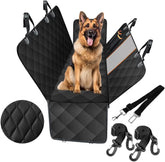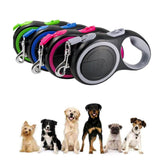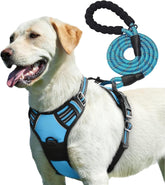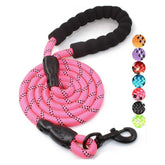Is your dog constantly doing a tail-chomping tango like it’s auditioning for a dance show? While you’re thinking, “Why does my dog keep chewing his tail?”. It might seem like a quirky habit at first, but tail chewing isn’t just oddball behavior—it’s a red flag indicating dog tail problems! From itchy skin to anxious hearts, this puzzling pattern has many possible culprits. Let’s find out the causes and find solutions, tail-wagging guaranteed.
Why Is My Dog Chewing His Tail? Top Reasons Explained
If you're a dog parent, then you must have thought that "Why is my dog chewing his tail?". Well, it isn't something uncommon, but definitely a concern for dog parents. The reason behind this behavior is physical or emotional factors.
1. Parasites (Fleas, Ticks, Mites)
Tiny but mighty in causing chaos, parasites love setting up camp near your dog’s tail base. The constant itching drives dogs to chew just to find relief.
2. Allergies
Dogs can be allergic to food, pollen, dust mites, or even that fancy new dog shampoo you just bought. Allergies often show up as tail irritation, prompting a chew-fest.
3. Skin Issues
Dry skin, hot spots, or dermatitis can start the loop cycle of dog tail skin infection. If it looks flaky, red, or scabby, it’s time to investigate further.
4. Boredom and Anxiety
Last but not least, another reason why dog chewing his tail is because they are bored. Sounds weird? No, it isn;t. Just like humans like to bite their nails, dogs may chew the tail. Chewing their tail becomes a way of self-soothing for anxious dog behavior.
5. Injury or Pain
From minor sprains to anal gland issues, hidden pain near the tail area can be the root cause. Your dog may chew as a response to discomfort.
Why Do Dogs Bite Their Tails Until They Bleed?
If you are constantly noticing that your dog biting its tail until it bleeds, then it's a serious concern. It is neither healthy nor it's safe for the dogs. Such action can cause severe infections and make the condition worse.
Compulsive Behavior
The habit of constantly chewing turns into an obsessive behavior if not taken necessary precautions for it. This leads to a daily habit and which in turn leads to bleeding.
Severe Allergic Reaction or Infection
If the itching is too much or if the dog has developed an allergic response, then it can cause unbearable itching or pain. To reduce discomfort or lessen the itching dogs are tend to bite until they don’t bleed.
Tail Injury
If the dog's tail has any kind of fracture, bruises, or sprain, then these dog tail injury symptoms can cause the dog to chew their tail for relief.
Neglected Parasites
A flea infestation left untreated can lead to extreme dog tail irritation and open wounds.
If the bleeding of the tail is in excess, then it makes the body vulnerable to other infections as well. If you spot redness or pus on your dog’s tail then it’s time you call vet and take immediate action.
Dog Chewing Tail Raw: When to Worry
So, your dog’s tail looks raw, red, or swollen? Here’s when to start worrying:
- You notice a few dog tail bald spot, scabs, or open wounds.
- Your dog is whining or yelping while chewing.
- The behavior has become obsessive, happening daily or for long periods.
- There are signs of infection (discharge, foul smell, inflammation).
If you have seen any of these symptoms, then it's advised to visit a vet. If you ignore the issue, then the habit of your dog chewing its tail might end up with long term infection or severe health problems for your pet buddy.
How to Stop a Dog from Chewing Its Tail
Now that we've covered the "why," let's go to the "how." Here's how to stop a dog from chewing its tail:
1. Visit the Vet First
Before attempting home remedies for a dog chewing tail habit, eliminate medical conditions such as parasites, infection, or gland issues. A veterinarian will also look for food or environmental allergy.
2. Employ an Elizabethan Collar (E-Collar)
The cone may not be your pup's most stylish look, but it's effective at keeping the tail out of reach when it's healing or undergoing treatment.
3. Increase Mental Stimulation
Bored canines = chewy canines. Buy dog enrichment toys, treat games, or scent games to keep their minds active and tails intact.
4. Boost Physical Activity
Longer walks, fetch, teething toys for dogs, and play can exhaust your dog and reduce anxiety or boredom, resulting in a diverted mind from chewing.
5. Try Calming Products
Use soothing diffusers, anxiety wraps, or calming toys for dogs meant to calm them. These may be particularly useful during thunderstorms or when being left alone.
6. Supervise and Manage Diet
If allergies are suspected, attempt to switch to a hypoallergenic or limited-ingredient dog food. Sometimes, a food trial is the only way to determine allergens.
7. Training and Redirection
Practice positive reinforcement strategies to refocus attention from tail chewing. Reward for relaxed behavior, and maybe use a safe chew toy to distract.
Final Thoughts
So, why does my dog keep chewing his tail? It could be anything from fleas to feelings. But one thing’s for sure: your dog isn’t doing it just to annoy you. Tail chewing is their way of telling you something’s up. Start with the vet, provide plenty of stimulation, and be patient—your pooch will be back to healthy tail-wagging in no time.















